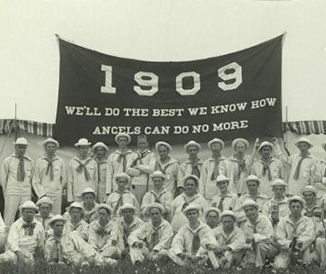
“This Is Gonna Work”
Thayer professor Lee Lynd stands in a walk-in cooler at Mascoma Corp., rifling through a lab cart piled with dozens of Hefty freezer bags that look like they are full of mulch. “This is it,” he says, stopping and holding one up. “This is what it looks like.”
“It” doesn’t look like much more than a bag of dirt, but it may very well be a crucial strand in the energy future of the United States and the world. It, in this case, is cellulose, here in the form of a bag of ground-up wood chips, but it could be a bag of ground-up corn stalks, switch grass or any of the other forms of the cellulose that makes up the majority of plant life on the planet. The trick is to profitably turn it into ethanol, put that ethanol in our cars and go back to driving around the country with fewer worries about terrorism, global warming or nefarious Big Oil activity in faraway places.
It’s not an easy trick, and Lynd hasn’t done it yet. Humans have known how to turn the seed of a plant—such as corn kernels—into whiskey and its cousin, ethanol, for millennia. And humans have been turning it into record quantities of auto fuel in the last few years: Ethanol production capacity in the United States now stands at 10 billion gallons per year. (U.S. auto fuel consumption runs well over 170 billion gallons per year.) But ligno-cellulose, inedible to humans, has evolved to resist attack by naturally occurring enzymes and microorganisms. This, Lynd says, is the central problem, which he refers to as “the recalcitrance of cellulosic biomass.” To profitably break down that cellulose into easily usable sugars would immediately introduce the world to an enormous new energy supply.
Roughly speaking, Lynd has been working on the problem for 30 years, since he was an undergraduate at Bates College in the late 1970s. Working on a farm one summer during the energy crisis of the 1970s, he noticed how hot the inside of a compost pile could get. Like Newton’s apple, that hot pile led Lynd to a senior thesis on converting biomass into ethanol, to three advanced degrees (including master’s and doctoral degrees in engineering from Thayer) and, eventually, his own company, Mascoma.
It would be hard to dispute that Lynd is among the top experts worldwide in the field. He has testified before the Senate Agriculture Committee on the role biofuels will play in national energy consumption, and in 2007 he was the inaugural winner of the $100,000 Lemelson-MIT Award for Sustainability. He is currently part of the Global Sustainability Project being organized by the Natural Resources Defense Council, with which he works closely. His approach, and that of Mascoma, which he cofounded in 2005 and where he serves as chief scientific officer (he also holds a minority stake), is to engineer a microorganism that will both break down the fibers that make cellulose so recalcitrant and turn the resulting sugars into ethanol. The scientific shorthand for the goal is “consolidated biomass processing.” Such a catalyst is, as various reports and articles have noted, the holy grail of biofuels. It would be a total solution—biomass in, fuel out.
In May Mascoma announced the development of a strain of yeast that produces higher-than-ever quantities of cellulase, or enzymes that consume cellulose; the successful cellular production of ethanol without adding any more cellulase (prior processes had required “restocking”); and two advances in the development of thermophilic bacteria, a strain of microbe that converts cellulose into ethanol.
“I truly believe,” says Lynd, “that we’re finally at the ‘This is gonna work’ stage.”
Lee Rybeck Lynd, 51, has been teaching at Thayer since 1987. He is an adjunct professor of biology and carries a full load of courses, including ENGS 161: “Metabolic Engineering” and ENGG 261: “Biomass Energy Systems.” He has sandy, wavy hair, and almost every published story about him—and there have been a few, especially during the run-up in oil prices, when alternative energy lived on the front pages—is obliged to mention that, though he doesn’t mind a dress shirt, he favors sandals without socks.
It’s a 10-minute commute from Lynd’s office at Dartmouth to the headquarters of Mascoma, located at the end of a road winding up the mountain behind the Hanover Co-op in the Centerra corporate park, a complex of high-tech offices. Seeded with $100 million in venture backing from green-tech capitalists such as Vinod Khosla, who made a fortune as a cofounder of Sun Microsystems, and up to $50 million committed by the U.S. Department of Energy (Dartmouth also took an equity stake in the company as part of a sponsored-research agreement, says Lynd), Mascoma has about 70 employees on two floors. With the business growing, the company is planning to move into a new building this fall.
Overall, the look of the Mascoma operation is a blend of Dr. Who and the Dartmouth Outing Club, with staffers dressed for hikes, but wearing safety glasses and moving among the clunky machinery of the laboratory.
A quick tour begins in the cooler, with the Hefty bags of wood chips. Next is the molecular biology lab, where airtight acrylic cabinets, the interior accessed by gloves mounted in holes, hold culturing samples of anaerobic microbes that work in oxygen-free environments. These microbes are the catalyst enzymes designed and patented by Mascoma.
“Mascoma is trying to directly address recalcitrance,” says Lynd. “Other companies are investing in converting the sugars. We are one of a minority of companies emphasizing recalcitrance. And we’re making the biggest bet on consolidated biomass processing.” In the fermentation lab the best of these all-in-one microbes are working in vats filled with water and wood chips, breaking down the cellulose and converting the harvested sugars. In the analytical lab staffers work to figure out what, in the end, the microbes hath wrought and how well. “At the end,” says Lynd, “we ask, ‘What have we done? How much cellulose did we treat?’ ”
Mascoma is one of several firms working to find or engineer a profitable way to turn cellulose into fuel. Verenium, based in Cambridge, Massachusetts, scours ponds, streams and the stomachs of grass-eating animals to find naturally occurring microbes. Colorado-based Gevo is engineering catalysts as well, but with the aim of creating butanol, a cousin of ethanol.
In the best of scenarios full-scale production of cellulosic ethanol is just a few years away. This, of course, has been a dream of energy scientists for years, but “a few years away” is looking closer than ever. Mascoma has built a $30 million ethanol plant in Rome, New York, on the site of an old Air Force base. (Half the cost was footed by the State of New York.) Mascoma is also partnering in the 2010 construction of a second facility in Kinross, Michigan, on the site of a former paper mill. “Paper waste,” says Lynd, “is ideal for ethanol.”
The competition, of course, is also building plants. Verenium’s operation in Louisiana, in the early stages of operation, is experimenting with turning the woody parts of sugarcane into fuel. If cellulosic ethanol ever takes off, the likely scenario would be as many as 100 such plants scattered around the country, turning local produce and waste into fuel for cars, providing perhaps a third of our overall fuel-for-transportation needs.
Money is the obstacle, as in so many pursuits. To make ethanol competitive, both the costs of the raw material and the costs of the enzymes to convert it have to come way down. Comparing a finished gallon of ethanol to a finished gallon of oil, the cost of raw material for the ethanol hovers around 75 cents a gallon. The cost of the enzymes alone, as it stands, doubles that figure. And then there is processing, transportation, marketing and all the other fixed costs that go into the price at the pump of a gallon of gas, pushing the end price of ethanol to more than $4 a gallon.
Doubters worry that there just isn’t enough land to grow enough biofuel. They cite studies that show that even if all available cropland were given over to fuel production we still might not be able to make enough fuel to replace the 20 million barrels of oil the United States uses every day, but Lynd points out that biofuel doesn’t have to be the only answer, just one good answer in a series of answers.
Lynd is not particularly modest about his ambitions for Mascoma or for his role in the movement of the United States to sustainable fuel use. “I’m trying to play a visionary role,” he says, sitting out in the sun in front of the Mascoma offices. “That’s probably because I come from a long line of social reformers. My father founded Freedom Schools in Mississippi during the civil rights movement. My mother was a draft counselor during Vietnam.”
Not surprisingly, he has a vision for Dartmouth, too. He would love to see a school more in the mode of a large institution with a busy research department. In his view such exposure to the real world would energize undergraduates, who would see what they are learning about advancing in practice. This is, of course, in direct opposition to the “it is a small College, and yet there are those who love it” folks who think “research” is a dirty word.
In this and other matters Lynd seems congenitally hopeful and optimistic, as anyone working on biofuels in the 1980s and 1990s must have been. Or perhaps it is the rush of the feeling that one’s time has finally come.
“We are knocking on a huge door,” says Lynd.
Bryant Urstadt is a contributing editor.










